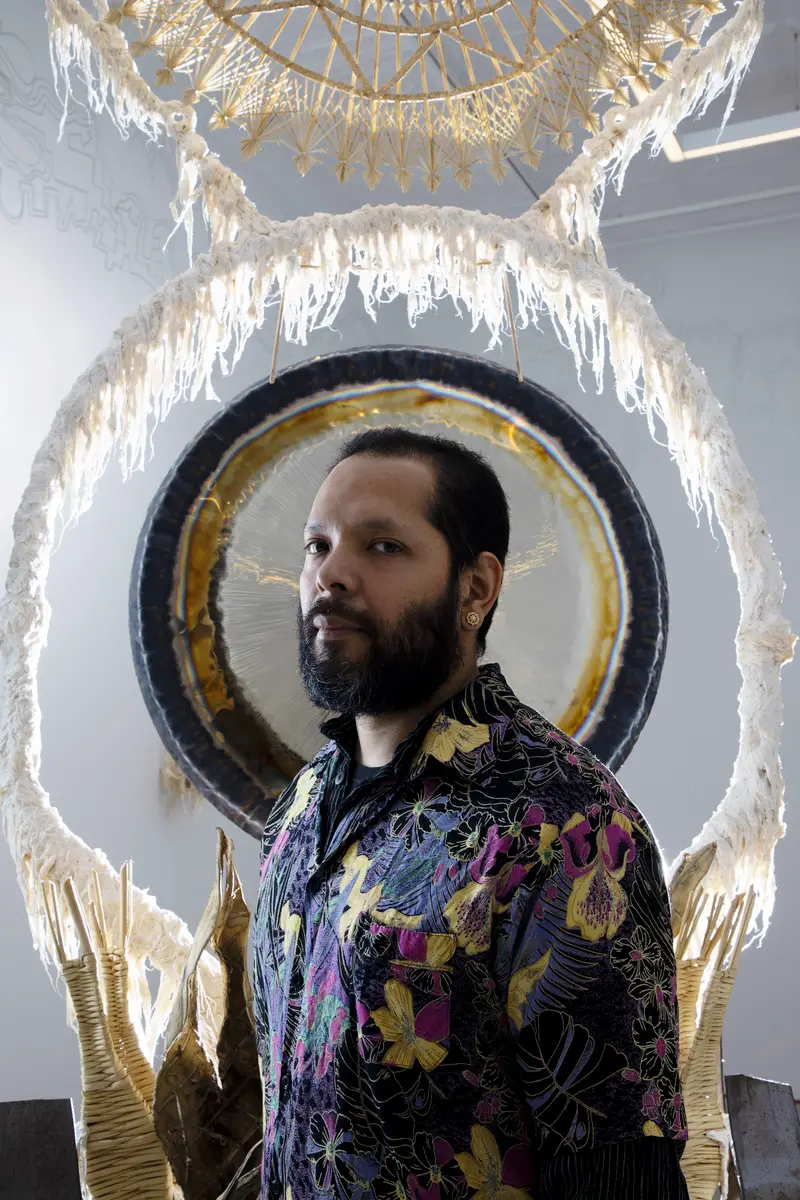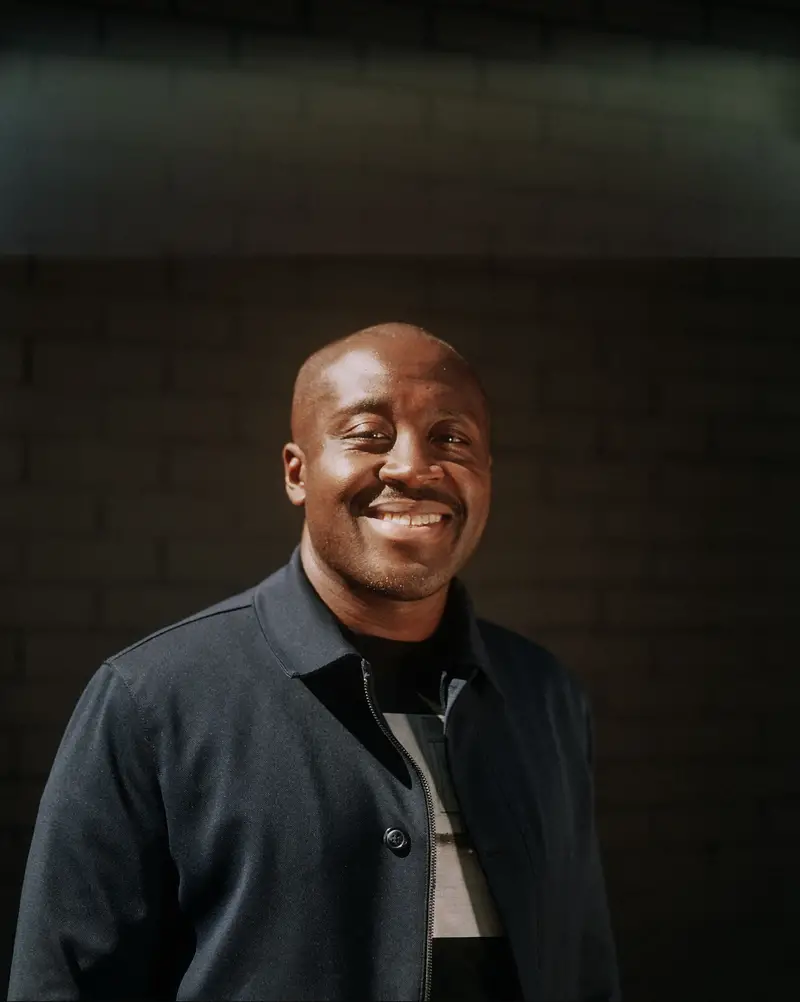Guadalupe Maravilla:
Installation view, Guadalupe Maravilla: Purring Monsters with Mirrors on Their Backs, Museum of Contemporary Art Denver, June 3, 2022–August 26, 2022. Photo by Wes Magyar.
Guadalupe Maravilla:
Larry Ossei-Mensah for MCA Denver
Guadalupe Maravilla is a transdisciplinary artist, healer, and activist, born in San Salvador, El Salvador, who utilizes his practice as a forum for collective healing. Anchored by the integration of his autobiographical experiences with issues of migration, displacement, and illness, Maravilla’s work centers communities that have historically been marginalized. Maravilla uses art to shed light on the collective traumas of undocumented immigrants and cancer survivors and empowers them with the tools to assist with their process of healing. For his exhibition at the MCA Denver, Maravilla will present new and recent work including a Retablo painting, a site-specific Tripa Chuca mural, and three Disease Throwers sculptures, one of which was specially commissioned for the exhibition.
Guadalupe Maravilla (b. 1976) came to the United States as an unaccompanied minor in 1984 fleeing war in his native El Salvador. While earning his MFA at Hunter College, Maravilla was diagnosed with stage 3 colon cancer. These challenges inform Maravilla’s practice and are expressed within the suite of works in this exhibition: the Disease Throwers that feature calibrated gongs and plastic replicas of organs, the Retablo painting, and the Tripa Chuca murals. Maravilla uses sound, ritual, and collaboration to create spaces for communities that relate to his own communal history. Acknowledging the global effects of COVID-19 and wealth disparity, Maravilla welcomes all visitors to engage with his practice but is particularly attuned to creating a space of welcome for undocumented immigrants, the Latinx and Central American community, the working class, and cancer survivors.
The Disease Throwers, begun in 2019, are a series of sculptures that take a variety of forms such as headdresses, shrines, and healing instruments. These sculptures, when activated during Maravilla’s sound bath ceremonies, create portals. The exhibition features Disease Thrower #17, 2021 which like many of the sculptures, includes objects that range from the quotidian to the sacred, such as wood, loofahs, an anatomical model of a snake head and heart, obsidian, and six gongs that are activated during his sound bath ceremonies. Made of cast aluminum and steel tubing Disease Thrower #14, 2021 reflects Maravilla’s adoption of new, more durable materials for his 2021 outdoor exhibition at Socrates Sculpture Park. These sculptures, along with the new Disease Thrower commissioned by MCA Denver, will be activated during a series of sound bath ceremonies on July 16 and 17.
The exhibition also features a new site-specific mural by Maravilla that is created by playing Tripa Chuca, a game Maravilla enjoyed as a child in El Salvador. The game Tripa Chuca provided the artist with comfort and cultivated a bonding experience with the other people he was traveling with during his migration from El Salvador to the United States. Hence, the process of drawing to create the Tripa Chuca mural centers on the importance of Maravilla forming a bond with his collaborator while creating a forum to explore notions of displacement, mapping, and abstraction as a form of storytelling.
MCA Denver thanks the citizens of the Scientific and Cultural Facilities District for their support of the exhibition.

About the artist
Combining sculpture, painting, performative acts, and installation, Guadalupe Maravilla (b. 1976) grounds his transdisciplinary practice in activism and healing. Engaging a wide variety of visual cultures, Maravilla’s work is autobiographical, referencing his unaccompanied, undocumented migration to the United States due to the Salvadoran Civil War. Culling the entangled fictional and autobiographical genealogies of border crossing accounts, Maravilla nurtures collective narratives of trauma into celebrations of perseverance and humanity. Maravilla currently lives in Brooklyn, New York. He received his BFA from the School of Visual Arts and his MFA from Hunter College in New York. His work is in the permanent collections of the Museum of Modern Art, New York; the Whitney Museum of American Art, New York; Museo Nacional Centro de Arte Reina Sofía, Madrid; the Institute of Contemporary Art, Miami; the Henie Onstad Kunstsenter, Olso; and the Blanton Museum of Art, Austin, among others. Additionally, he has performed and presented his work at the Whitney Museum of American Art, New York; the Metropolitan Museum of Art, New York; the Institute of Contemporary Art, Miami; Queens Museum, New York; The Bronx Museum of the Arts, New York; El Museo del Barrio, New York; Museum of Art of El Salvador, San Salvador; X Central American Biennial, Costa Rica; Performa 11, New York; Performa 13, New York;, Shelly & Donald Rubin Foundation, New York; the Drawing Center, New York; SITE Santa Fe, New Mexico; the Moody Center for the Arts at Rice University, Houston, Texas; and the Contemporary Art Museum St. Louis, Missouri, among others. Maravilla has received numerous awards and fellowships including; Joan Mitchell Foundation Inaugural Fellowship, 2021; Andrew W. Mellon Foundation & Ford Foundation Latinx Artist Fellowship, 2021; Guggenheim Foundation Fellowship, 2019; Soros Fellowship: Art Migration and Public Space, 2019; MAP Fund Grant, 2019; Franklin Furnace Fund, 2018; Virginia Museum of Fine Arts Fellowship, 2018; Art Matters Fellowship, 2017; Creative Capital Grant, 2016; The Robert Mapplethorpe Foundation Award 2003, among others. He has also completed residencies with the Lower Manhattan Cultural Council, New York; SOMA, Mexico City; Skowhegan School of Painting & Sculpture, Maine; and the Drawing Center, New York.

About the Curator
Larry Ossei-Mensah uses contemporary art as a vehicle to redefine how we see ourselves and the world around us. The Ghanaian-American curator and cultural critic has organized exhibitions and programs around the globe at such organizations as Twitter, Marianne Boesky Gallery, MOAD, MASS MoCA, and most recently he co-curated with Omsk Social Club 7th Athens Biennale in Athens, Greece in 2021. Ossei-Mensah is the former Susanne Feld Hilberry Senior Curator at MOCAD in Detroit and currently serves as Guest Curator-at-Large at The Brooklyn Academy of Music. A native of the Bronx, Ossei-Mensah is also the co-founder of ARTNOIR, a 501(c)(3) and global collective of culturalists who design multimodal experiences aimed to engage this generation’s dynamic and diverse creative class.
